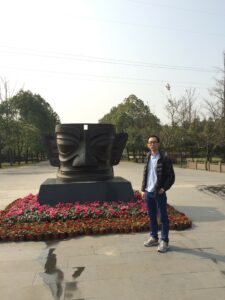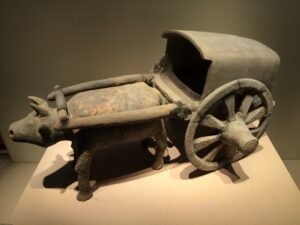Engaged Anthropology Grant: Minghao Lin

While a doctoral student at the University of Cambridge, Cambridge, United Kingdom, Minghao Lin received a Dissertation Fieldwork Grant in 2012 to aid research on “The Origin and Early History of Oxen Plowing in China,” supervised by Dr. Preston Miracle. In 2015 Dr. Lin received an Engaged Anthropology Grant to aid engaged activities on “The Early History of Cattle Traction in North China”.
I started my journey from Jinan, Shandong Province, in early March, by delivering an academic presentation, entitled “Cattle traction and its role in the making of Chinese early civilization”, to my colleagues at the School of Culture and Heritage, at Shandong University. My research questions were first clarified to them: why is the exploitation of cattle labor important to understand human history? What do we know now (prior to my project) regarding this question? A systematic review was elaborated from lines of evidence including historical documents, oracle and bronze scripts, picturing records, and archaeological remains. Then my talk went to the theory and methods my project had been applied. After successfully establishing the comparative models from modern control samples, I then applied these reliable models to interpret Chinese archaeological assemblages, revealing intensive cattle traction had been exploited since the Late Shang period (c. 1300-1046 BC). It was the intensive use of cattle labour that helped build the fantastic civilisation in Chinese Bronze Age, as characterized by the Late Shang. I finally closed my speech and speculated some likely scenarios by weaving my results into the broader trans-Eurasian network in the Old World.

The success of my talk in Shandong University rendered me more confidence and enthusiasm to continue my scheduled trip to spread out my research results with other Chinese colleagues in other institutes. In the following few weeks, I traveled among many cities across nearly the whole China by means of flights or trains, to further address the significance of the exploitation of animal power in human history. Apart from personally discussing this topic with professors, I also contributed with a formal academic speech at these institutes, such as Northwest University (Xi’an), Sichuan University (Chengdu), Peking University (Beijing) etc.
To summarize, there were three levels of knowledge flow from my research trip. First, not only the prestigious professors, those students (both undergraduates and graduates) were also impressed by my research methods and discussion within the broader trans-Eurasian context. Some of these students expressed that the pictures I drew in my talk had, to some extent, enlightened them to well construct their own thesis projects, which makes my efforts over these weeks much worthwhile. Meanwhile, I also benefited from the discussion with those professors and students in terms of how to address my research questions from other interesting perspectives. Second, apart from preparing the talks, I was also interested in seeking potential lines of evidence to broaden my expertise, within which visiting local museums was a useful means. By exploring the Sanxingdui civilization in Sanxingdui Museum, I have been considering the role of cattle traction in building its own civilization as well as its connection with the civilizations in the Central Plains region. The pottery model at Nanjing Museum vividly displayed the use of cattle in dragging a cart in Chinese historic period. Three, non-archaeologists were also impressed by the information revealed from small pieces of cattle lower limb bones. For them, this was not only an academic seminar to understanding the ancient cultures in China, but also helped build the sense of preserving multiple archaeological remains – even pieces as fragmental as cattle feet bones could deliver important messages from the past. As such, this served as a good opportunity to educate the general public.

This Engaged Anthropology Grant has provided me this valuable chance to engage with the Chinese colleagues, which becomes one of my unforgettable experiences. The support from Wenner-Gren is even more significant for Chinese zooarchaeology, as this field has just been aroused in the most recent decade to contribute to our understanding of the past civilizations.